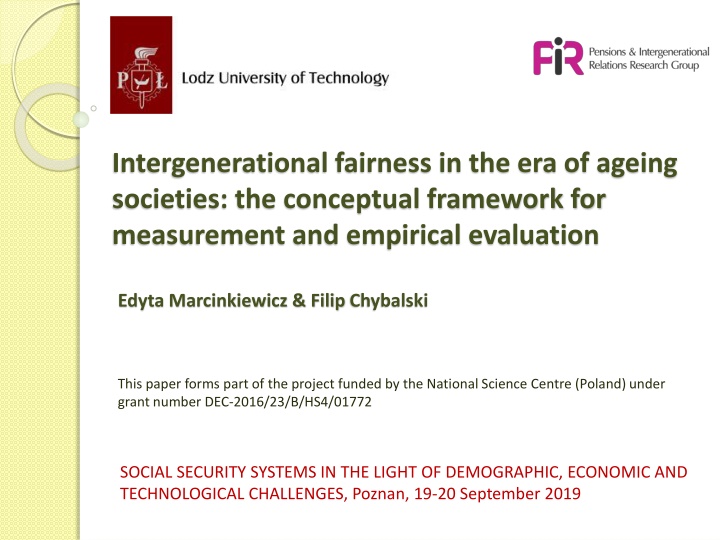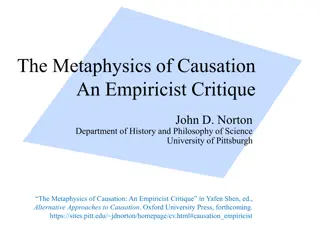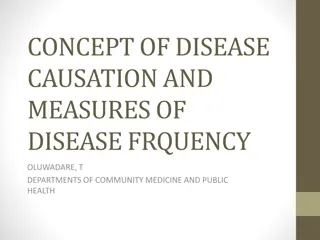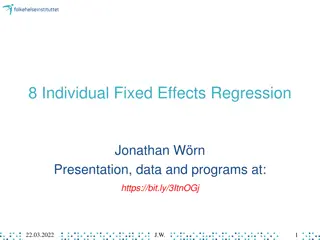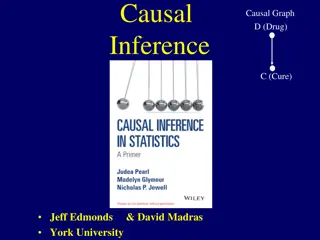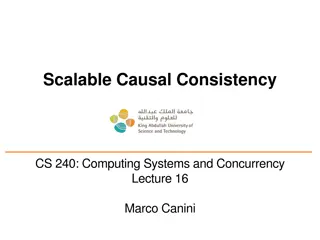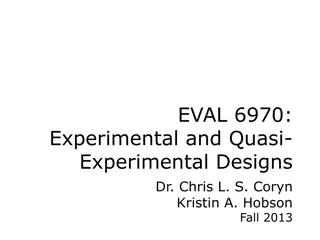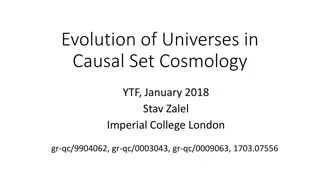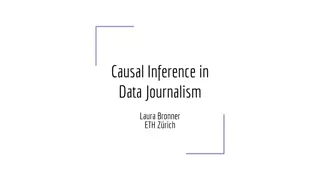Causal Discovery: A New Explanation of Ockham's Razor
This presentation delves into the intricacies of causal discovery, examining the relationship between prediction and policy, the distinction between correlation and causation, and the implications of different approaches in understanding causal relationships using real-world examples.
Download Presentation

Please find below an Image/Link to download the presentation.
The content on the website is provided AS IS for your information and personal use only. It may not be sold, licensed, or shared on other websites without obtaining consent from the author.If you encounter any issues during the download, it is possible that the publisher has removed the file from their server.
You are allowed to download the files provided on this website for personal or commercial use, subject to the condition that they are used lawfully. All files are the property of their respective owners.
The content on the website is provided AS IS for your information and personal use only. It may not be sold, licensed, or shared on other websites without obtaining consent from the author.
E N D
Presentation Transcript
Intergenerational fairness in the era of ageing societies: the conceptual framework for measurement and empirical evaluation Edyta Marcinkiewicz & Filip Chybalski This paper forms part of the project funded by the National Science Centre (Poland) under grant number DEC-2016/23/B/HS4/01772 SOCIAL SECURITY SYSTEMS IN THE LIGHT OF DEMOGRAPHIC, ECONOMIC AND TECHNOLOGICAL CHALLENGES, Poznan, 19-20 September 2019
Background & Motivation The significant demographic change experienced mainly by developed countries has clear consequences for intergenerational relations as the quantitative proportions between young, adult and elderly people have been changing. As argued in many previous studies, the welfare consequences of demographic changes in developed countries are already perceptible or will be faced in the near future (see e.g. B rsch- Supan, H rtl, & Ludwig, 2014; Ludwig, Schelkle, & Vogel, 2012; Vartiainen, 2017; V ron, Pennec, & L gar , 2007) Although the literature delivers many recommendations how to make effective social policy taking also an intergenerational perspective into account, our knowledge about how to measure intergenerational relations in terms of justice, equity or fairness still seems to be very poor.
Goal This paper aims to propose a conceptual and empirical framework to measure and evaluate intergenerational fairness in a cross-country perspective which can serve for the comparative assessment of the outcomes of various policies. It contributes to the discussion on intergenerational conflict in terms of welfare provision.
Conceptual framework approach to the time perspective and generations temporal (static), not a long-term (dynamic), outlook age groups identified with generations (in line with e.g Birnbaum et al. 2017)
Conceptual framework understanding of fairness and the scope of reference fairness = addressing the needs of different generations and protecting them equally against age-specific risk. It implies a temporal balance between generations in this respect. There is a category of social justice conceptions focusing on how resources can be distributed in a way that helps citizens relate to one another as equals at all stages of life (Birnbaum et al. 2017, p. 22)
Conceptual framework operationalization and measurement of fairness approach based on outputs (i.e. performance of social policy), as opposed to inputs (i.e. social expenditures, benefits or entitlements) examples of previous empirical studies of intergenerational balance/fairness/equity: inputs - Tremmel & Vanhuysse (2019), Birnbaum et al. (2017), Ch o - Domi czak et al.(2019) inputs+outputs - Leach et al. (2016), Leach & Hanton (2012, 2015), Gagne et al. (2016)
Conceptual framework operationalization and measurement of fairness In our study, we do not aim to explain in which countries intergenerational relations perceived through the prism of fairness are balanced or not in absolute terms, but in which countries the situation is more balanced or fair in comparison to other countries.
Empirical research Aim: to identify empirically patterns of intergenerational balance (fairness) with reference to socio-economic outcomes of social policy. Data: indicators provided by Eurostat (EU-SILC and LFS) for age groups <18, 18-65, >65, as well as genders (for respective age gropus) Coverage of the study: 25 European countries Time span: 2017 Methods: statistical multivariate analysis (linear ordering, hierarchical clustering, k-means clustering)
Empirical research dimensions and variables ??<18 ?????? ????????= Poverty RPRyoung, RPRadult, RPRelderly- Relative poverty ratio RSMDyoung, RSMDadult, RSMDelderly- Relative severe material deprivation rate GD_PRyoung, GD_PRadult, GD_PRelderly- Gender difference in poverty rate GD_SMDyoung, GD_SMDadult, GD_SMDelderly- Gender difference in severe material deprivation rate Income RMIyoung, RMIadult, RMIelderly- Relative median income ratio RS80/S20young&adult, RS80/S20elderly- Relative income quantile share ratio GD_MIyoung, GD_MIadult, GD_MIelderly- Gender difference in median income GD_S80/S20young&adult, GD_S80/S20elderly - Gender difference in income quantile share ratio Housing RHCOyoung, RHCOadult, RHCOelderly- Relative housing cost overburden rate RMHCyoung, RMHCadult, RMHCelderly- Relative median of the housing cost burden distribution RORyoung, RORadult, RORelderly- Relative overcrowding rate GD_HCOyoung, GD_HCOadult, GD_HCOelderly- Gender difference in housing cost overburden rate GD_MHCyoung, GD_MHCadult, GD_MHCelderly- Gender difference in median of the housing cost burden distribution GD_ORyoung, GD_ORadult, GD_ORelderly- Gender difference in overcrowding rate Labour market RUnempyoung, RUnempadult- Relative unemployment rate GD_Unempyoung, GD_Unempadult- Gender difference in unemployment rate Education REduyoung, REduadult, REduelderly- Relative education attainment level (5-8 ISCED) GD_Eduyoung, GD_Eduadult, GD_Eduelderly -Gender difference in education attainment level (5-8 ISCED) Health care RUMNyoung, RUMNadult, RUMNelderly- Relative unmet medical needs GD_UMNyoung, GD_UMNadult,GD_UMNelderly- Gender difference in unmet medical needs ??_???????= ??<18_? ??<18_?
Empirical research - methods Synthetic indicators used for cluster analysis: Syoung, Sadult, Selderly, GDyoung, GDadultand GDelderly where: ? =1 6?? + ?? + ?? + ?? + ?? + ?? each ?? =1 6??_?? + ??_?? + ??_?? + ??_?? + ??_?? + ??_?? each where a star (*) denotes variables transformed into the greater the better kind and scaled into a 0-1 interval
Empirical research - results Results of hierarchical agglomerative clustering Results of k-means clustering Cluster 1: Germany, France, the Netherlands, Austria and Slovenia Cluster 2: Czechia, Greece, Hungary, Poland, Portugal, Finland, Sweden and Switzerland Cluster 3: Estonia and Latvia Cluster 4: Belgium, Denmark, Ireland, Spain, Italy, Luxembourg, Slovakia, United Kingdom, Iceland and Norway.
Empirical research - results Mean values of synthetic indicators across clusters 0,9 0,8 0,7 0,6 0,5 0,4 0,3 S_young S_adult S_elderly GD_young GD_adult GD_elderly Balanced Supporting adult Discriminating against elderly Supporting elderly Cluster 1 ( Balanced ): a similar position of the adult and elderly generations; gender inequalities are the smallest in this group of countries in average terms (mean gender differences indicators for all three generations are the highest and they are close to 1). Cluster 2 ( Supportingadult ): adults benefit more in terms of welfare outcomes compared to other clusters; a worse position of the young and elderly generations; gender inequalities in all three generations are slightly greater than in Cluster 1, but dispaly a similar pattern Cluster 3 ( Discriminating against elderly ): the gap between the average position of the elderly and the average position of the two remaining generations is the greatest; the elderly have the weakest position and gender inequalities are the greatest in this generation (as compared to other countries). Cluster 4 ( Supportingelderly ): a quite reversed pattern comparing to Cluster 3; both indicators calculated for the oldest generation assume the highest values in average terms, as compared to other generations in this cluster as well as to the oldest generation in other clusters
Concluding remarks In European countries four distinct patterns of intergenerational (im)balance in terms of welfare outcomes can be empirically identified. However, comparing to previous empirical studies that rely solely on inputs or mix inputs with outputs, we cannot find much similarities in country composition of different models. Thus, our findings reveal that shifting the perspective from inputs to outputs alters the results of cross-country comparisons in terms of intergenerational fairness. The preliminary results indicate that the identified groups hardly display a common pattern with welfare state regimes as introduced by Esping-Andersen (1990, 1999) and further widely developed in the body of literature. Thus, our findings do not allow for the conclusion that there is a linkage between welfare state regime and the relative position of generations as well as gender equality across generations. However, some more detailed insight is required in this respect. We found no evidence for pro-elderly bias of welfare state (Berry 2012). The countries which constitute Supporting elderly cluster are very divergent with reference to old age dependency ratio, and some of them (Iceland, Slovakia, Luxembourg , Ireland, Norway) have the lowest levels of ODR rates in the EU.
Symbol Description Eurostat definition PR At risk of poverty rate The share of persons with an equivalised disposable income below the risk-of-poverty threshold, which is set at 60% of the national median equivalised disposable income (after social transfers). SMD Severe material deprivation rate The percentage of the population that cannot afford at least four of the following nine items: to pay their rent, mortgage or utility bills; to keep their home adequately warm; to face unexpected expenses; to eat meat or proteins regularly; to go on holiday; a television set; a washing machine; a car; a telephone. Median equivalised disposable income. Equivalised disposable income is the total income of a household, after tax and other deductions, that is available for spending or saving, divided by the number of household members converted into equalised adults; household members are equalised or made equivalent by weighting each according to their age, using the so-called modified OECD equivalence scale. The ratio of total income received by the 20% of the population with the highest income (top quintile) to that received by the 20% of the population with the lowest income (lowest quintile). Income must be understood as equivalised disposable income. Percentage of the population living in a household where total housing costs (net of housing allowances) represent more than 40% of the total disposable household income (net of housing allowances). The median of the distribution of the share of total housing costs (net of housing allowances) in the total disposable household income (net of housing allowances) MI Median income S80/S20 S80/S20 income quantile share ratio HCO Housing cost overburden rate MHC Median of the housing cost burden distribution OR Overcrowding rate The percentage of the population living in an overcrowded household. A person is considered as living in an overcrowded household if the household does not have at its disposal a minimum number of rooms equal to: one room for the household; one room per couple in the household; one room for each single person aged 18 or more; one room per pair of single people of the same gender between 12 and 17 years of age; one room for each single person between 12 and 17 years of age and not included in the previous category; one room per pair of children under 12 years of age. Unemployed persons as a percentage of the labour force. The labour force is the total number of people employed and unemployed The percentage of population with tertiary education. Tertiary education is an aggregate that covers ISCED 2011 levels 5, 6, 7 and 8 (short-cycle tertiary education, bachelor's or equivalent level, master's or equivalent level, doctoral or equivalent level, online code ED5-8 tertiary education ). Unmet needs for medical examination - the indicator measures the share of the population aged 16 and over reporting unmet needs for medical care due to one of the following reasons: Financial reasons , Waitinglist and Too far to travel (all three categories are cumulated). Self-reported unmet needs concern a person s own assessment of whether he or she needed medical examination or treatment (dental care excluded), but did not have it or did not seek it. Unemp Unemployment rate Edu Population by educational attainment level (levels 5-8 according to ISCED classification) Unmet medical needs UNM
